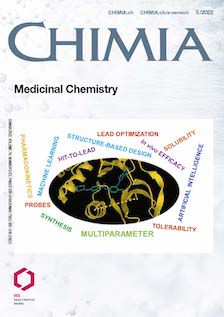Reverse Design toward Optimized Labeled Chemical Probes – Examples from the Endocannabinoid System
DOI:
https://doi.org/10.2533/chimia.2022.425PMID:
38069714Keywords:
Academia–industry collaboration, Chemical probe, Drug discovery, Endocannabinoid system, Reverse designAbstract
Labeled chemical probes are of utmost importance to bring drugs from the laboratory through the clinic and ultimately to market. They support and impact all research and discovery phases: target verification and validation; assay development; lead optimization; and biomarker engagement in the context of preclinical studies and human trials. Probes should display high potency and selectivity as well as fulfill specific criteria in connection with absorption, distribution, metabolism, excretion and toxicology (ADMET) profile. Progress in fields such as imaging and proteomics increased the need for specialized probes to support drug discovery. Labeled probes carrying an additional reporter group are valuable tools to meet specific application requirements, but pose significant challenges in design and construction. In the reverse-design approach, small molecules previously optimized in medicinal chemistry programs form the basis for the generation of such high-quality probes. We discuss the reverse design concept for the generation of labeled probes targeting the endocannabinoid system (ECS), a complex lipid signaling network that plays a key role in many human health and disease conditions. The examples highlighted include diverse reporter units for a range of applications. In several cases the reported probes were the product of mutually rewarding and highly cross-fertilizing collaborations among academic and industry research programs, a strategy that can serve as a blueprint for future probe generation efforts.
Downloads
Published
Issue
Section
License
Copyright (c) 2022 Mónica Guberman, Miroslav Kosar, Anahid Omran, Erick M. Carreira, Marc Nazaré, Uwe Grether

This work is licensed under a Creative Commons Attribution 4.0 International License.







